Sengakuji Temple and the 47 Ronin
Doing a post on the Sengakuji Temple and the story of the 47 Ronin almost feels dangerous. Everyone has an opinion on the tale, what Bushido means, and what is honorable. I’m just going to try to summarize the story and tell you about my visit to the temple; you can make judgments on your own. Deal? Good.
In the year 1701, by the Western calendar, several daimyo, or feudal lords, were asked to take part in a reception for the Emperor in Edo. One of these daimyo was Asano Takumi-no-Kami Naganori, the young leader of a branch of the powerful Asano family.
On April 14th, 1701, while Lord Asano was preparing for the event, he found himself out of favor with the master of protocol, Kira Kozuke-no-Suke Yoshinaka. Kira decided to publicly embarrass Lord Asano, something Asano took great exception to. Asano, in anger, drew his sword and struck Kira, but only wounded him.
It was against the law to not only draw your sword within the Shogun’s Palace, but also to strike anyone in anger, a double whammy against Asano. He was forced to commit seppuku, or ritual suicide, dying only with the regret that he hadn’t killed Kira.
With the death of Lord Asano his followers were left without a leader, becoming masterless samurai, or Ronin.
Now this is where things get interesting. Most people believe that bound by the code of bushido, the 47 ronin should have immediately attempted to avenge their master, regardless of the cost, including each of their lives, but they didn’t do this. They waited.
For nearly two years they acted as farmers and merchants and waited for Kira to believe they wouldn’t attempt to avenge their master, increasing their odds of success. And on the night of December 14th, 1702, using armor and weapons they had crafted themselves in order not to arouse suspicion, they attacked.
The 47 men descended on Kira’s mansion and cut down any man that stood in their way; many of Kira’s men lost their lives. As things quieted down Kira was nowhere to be found, and the men spread out to find him. After an exhausting and fruitless search the men found a secret courtyard hidden behind a banner on a wall and in the courtyard they found a man hiding in a coal shed. The man wouldn’t give his name, but the scar on his head told them it was Kira.
Oishi Kuranosuke Yoshio, Lord Asano’s principal counselor, offered Kira the same dagger Asano had used to commit seppuku and told him he would act as his Kaishakunin, or second. Meaning that as Kira committed seppuku, Oishi would sever his head so he wouldn’t have to suffer long. Kira refused to respond and eventually the ronin was forced to behead him.
The ronin carried Kira’s head to Sengakuji temple, the burial site of Lord Asano, washed his head in a well, and presented the head at the grave of their master.
Though the ronin had followed the code of bushido, the shogunate was bound by law to sentence them to death. Each committed seppuku, and were buried alongside their master at Sengakuji Temple.
This story is well known throughout Japan, and all over the world, as an example of loyalty, honor, and self-sacrifice.
The temple grounds are small, and to some, architecturally unimpressive. It’s the history behind this place that make it, in my opinion, a must see for anyone traveling to Tokyo.
A small fountain to honor the 47 ronin with an accompanying layout to show where each man is symbolized.
You can see in this photo that when I was visiting it was raining. I’d arrived early in the morning and was the only one on the grounds besides a gentleman selling incense for placement at the graves, the museum keeper, and the crows. A great atmosphere.
Another small layout of the graves. I try to include things like this so people can read the signs and displays as if they were actually visiting. And to be honest, it gives me something to refer back to later when my memory isn’t so fresh.
These headstones were outside of the main burial area and are of a different style than that of the 47 ronin. I’m not sure who these markers belong to, but if anyone knows please leave the information in the comments.
These are the headstones of the 47 ronin. I love the style of these headstones. The look of the rough cut, like they’ve been torn from the rock, while having the name of the individual carved into a smooth stone surface. Seriously, it’s pretty damn stylish.
You can see that in front of the headstones their is a small area where incense is normally burning. Because there was a constant light rain I wasn’t able to capture the incense burning, but normally this area would be filled with smoke.
Just before reaching the main resting place there was a small shack with a guy selling bundles of incense for placement at the graves. I didn’t buy any on this trip but I’ll have to the next time I’m in town.
This is Oishi’s grave, it is a bit larger I imagine due to his status as the leader of the 47 ronin. As a side note, you can see a small blue-green and white cup in front of the headstone. I bought a set of these cups at a small gift shop just outside the temple grounds. They’re one of my favorite souvenirs from my trips to Japan.
This is the well where the ronin washed the head of Kira before presenting it at Asano’s grave. They’ve put a mesh guard over it to keep people from tossing things into it, which is too bad, I would have liked to get an unobstructed picture. Still, it’s a powerful thing to see the actual well where Kira was washed over 300 years ago.
There’s a small museum on the grounds that has the actual armor worn during the attack, a receipt for the head of Kira when it was collected by two of Kira’s friends, and many other important items from the events, and they can all be seen for just ¥500.
I’m a huge fan of Sengakuji Temple and the story of the 47 ronin. To me it’s the story of ultimate loyalty, and I had to see it when I arrived in Tokyo. I highly recommend stopping by, you’ll only need an hour or so, but it’s an hour you won’t soon forget.
Open: Daily from 7:00AM to 6:00PM (7:00AM to 5:00PM from October to March).
The memorial museum is open from 9:00AM to 4:00PM.
Admission: Free for temple grounds and burial site. ¥500 for the memorial museum.
Phone: 03-3441-5560

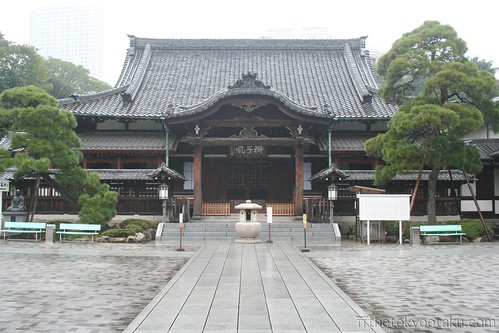
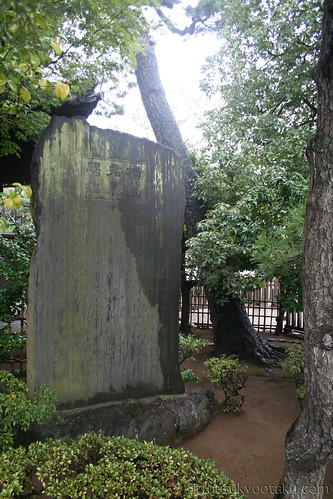
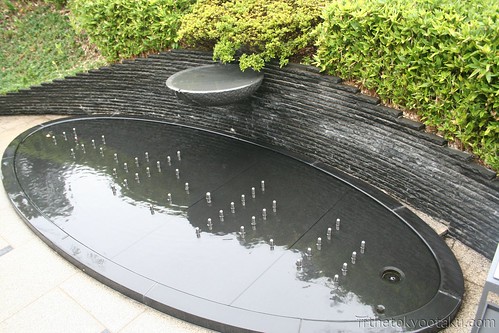
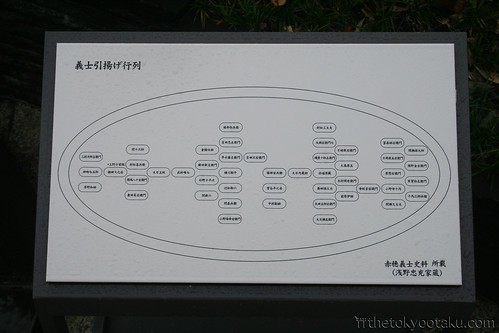
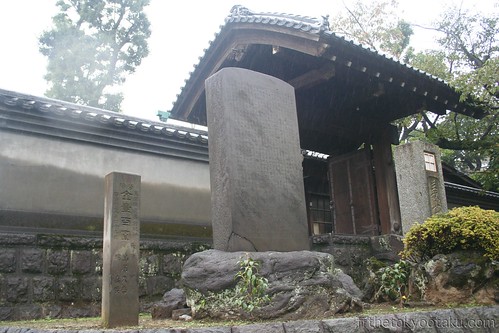
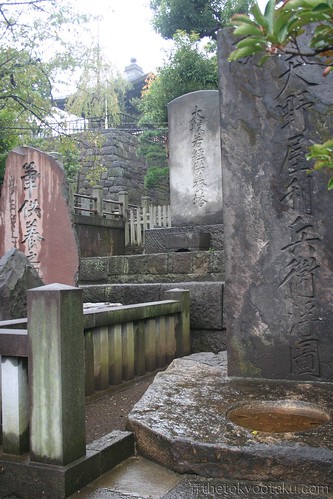
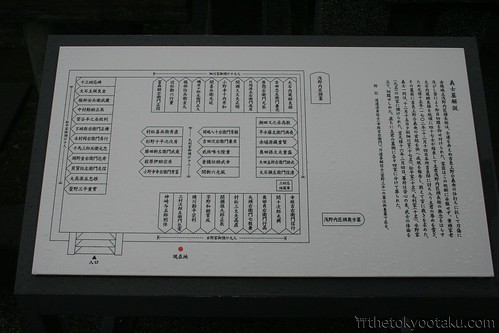

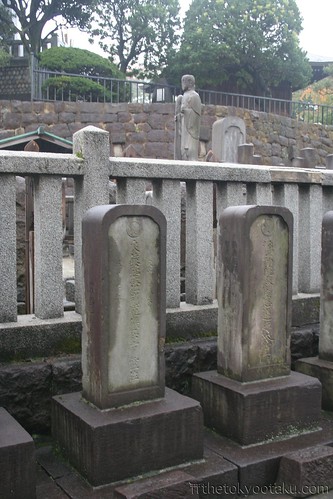

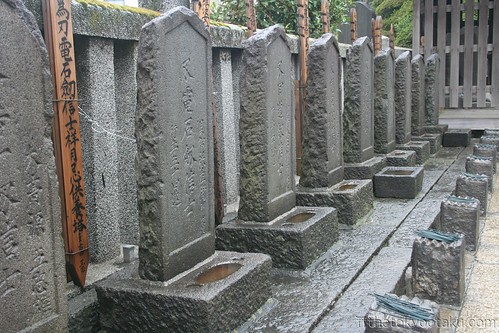

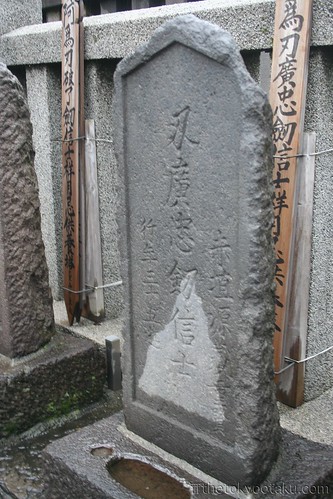
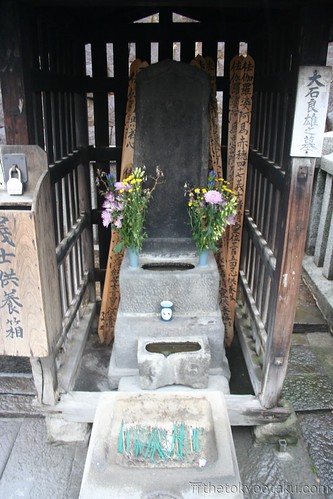
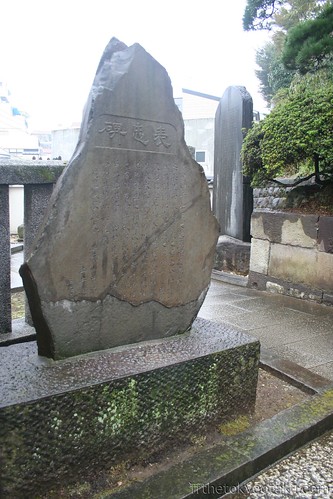

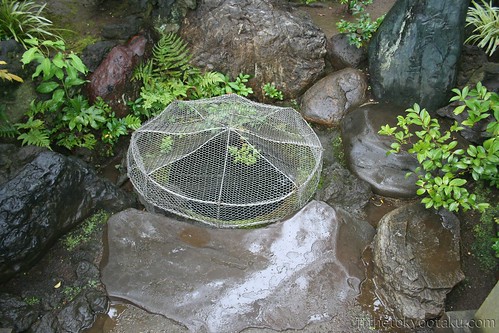








[…] Picture retrieved from The Tokoyo Otaku websitehttp://www.thetokyootaku.com/2009/09/sengakuji-temple/ […]
[…] sáida: Omotesando. Outro templo famoso dentro da cidade é dos 47 ronins, chama-se Sengaku-ji : Templo dos 47 ronins . A lenda (história?) conta como 47 samurais se tornaram ronins (samurai sem senhor) e no templo […]
[…] http://www.thetokyootaku.com/2009/09/sengakuji-temple/ the tokyootaku blog post about the Chushingura and Sengakuji […]
Leave your response!
You must be logged in to post a comment.
Blogroll
Meta
Tags
Recent Posts
Most Commented
Archives